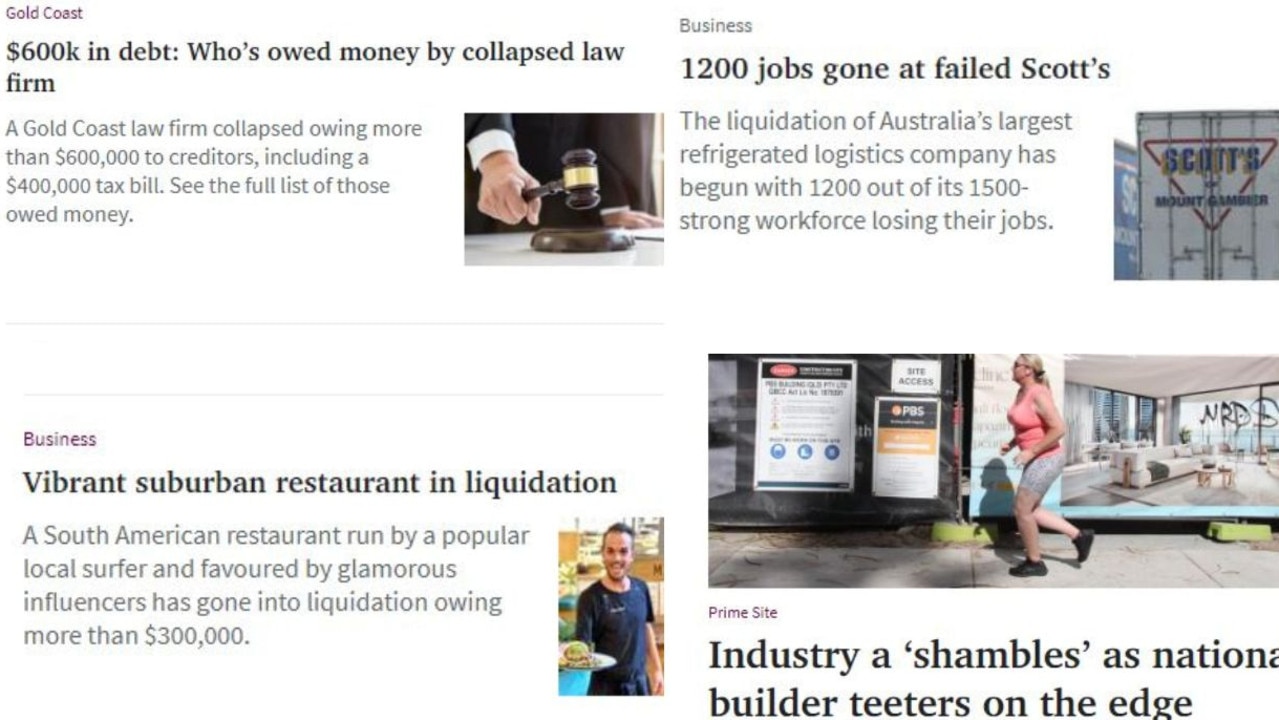‘Big squeeze’: Aussie firms at risk of insolvency as companies collapse across the nation
A quick glance over Australia’s top news outlets has revealed a terrifying trend sweeping the nation – and there’s more grim news ahead.

A quick glance over Australia’s leading news outlets has revealed a terrifying trend sweeping the nation – and there’s more grim news ahead.
At Queensland’s Courier Mail, one alarming headline screams: “Industry a ‘shambles’ as national builder teeters on the edge”.
At The Gold Coast Bulletin, there’s news of a law firm that has collapsed with $600,000 in debt, as well as a popular influencer-adored restaurant that is also in liquidation owing $300,000.
The Advertiser is reporting on shop vacancies along the iconic Rundle Mall following a string of store closures, while The Daily Telegraph is concerned with 1200 job losses after Australia’s largest refrigerated logistics company abruptly folded.
And on the news.com.au homepage, there’s more worrying economic news, with tech giant Atlassian laying off 500 workers and a Sydney building company that stopped work on construction sites months ago finally collapsing, impacting up to 19 homeowners.

It paints a depressing picture of the state of the Australian economy, with companies across many industries battling a perfect storm of conditions including soaring inflation, plummeting consumer confidence, skyrocketing interest rates and a labour shortage, among other dire factors.
And according to a new analysis, more bad news is coming – fast.
Digital credit reporting agency CreditorWatch recently released its latest Business Risk Index, revealing there was a “big squeeze” from rising costs and falling demand pressuring countless businesses.
CreditorWatch chief economist Anneke Thompson began the report by noting that many retailers have now “downgraded or emphasised caution in their outlook for sales in the year ahead”, with groups like Adairs, JB HiFi and Baby Bunting all highlighting that future sales in many categories are likely to be lower.
“This year we will see the impact of many more consumers having less to spend each month, as up to 800,000 fixed rate loans on very low interest rates will convert to variable rate loans,” Ms Thompson notes.
“We will also see the added impact of housing completions begin to trend down from about the middle of the year.
“This will affect sales in the furniture, white goods and electrical goods categories.”
Meanwhile, the report also confirmed the“higher risk of insolvency for sectors reliant on discretionary spending, with the food and beverage sector topping the list of riskiest sectors at a 7.3 per cent probability of default”.
Citing a recent Finder survey which found 51 per cent of Aussies attempting to cut back on spending were reducing their dining and drinking out habits, while 36 per cent were limiting how often they go to events such as to the movies, sporting games and concerts, Ms Thompson said it “emphasises the risk of this sector, as business owners will now not only be grappling with high costs, wages, interest payments and rents, but also lower demand”.

Meanwhile, the report also noted that inflation was still “well above the RBA’s target rate of 2-3 per cent and may not get back to that level until 2025” as a result of supply factors including the Ukraine war and weather events impacting crops.
As for retail data, Ms Thompson noted that “household goods retailing is one sector where trade is well below 2022 levels and is in fact trading at or about the level it was in October 2021”.
“This is likely a result of households pulling back on large expenditure and a flow on impact of many people making large purchases for their houses during lockdown periods,” she said.
“It is likely that as we see the peak of housing completions reached in around mid 2023, that household goods trading will continue to remain flat or even trend down.”
Jobs data also shows a drop in the number of advertised roles across almost all industries, with the information and communication technology sector facing the biggest fall, followed by hospitality and tourism.
Finally, the report also exposed the growing problem of late payments plaguing many businesses, which were three times greater for small business relative to big business in January, “reflecting differences in the ability of small businesses to enforce payment terms and collect on payment arrears, and the willingness of some businesses to treat smaller suppliers as an interest free bank”.
“Payment arrears have been slowly trending down across all industries but continue to be a problem in the construction industry … in January, 11.6 per cent of small construction businesses had payments that were 60 days or more in arrears compared to just 2.3 per cent of large businesses,” the report concluded.






